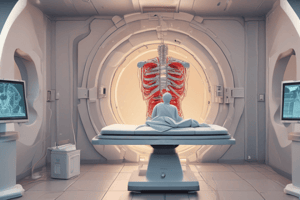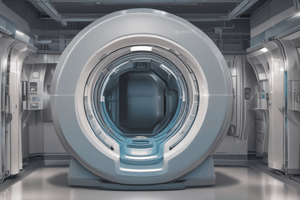Podcast
Questions and Answers
What is a characteristic of the described technique for data acquisition?
What is a characteristic of the described technique for data acquisition?
- Data is continuously acquired without interruption. (correct)
- Data collection pauses during patient transport.
- Data is collected in intervals correlating with patient movement.
- Data is gathered only when the patient is stationary.
What must be constant during the patient’s transportation in this technique?
What must be constant during the patient’s transportation in this technique?
- The communication with the patient.
- The type of data being collected.
- The speed at which the patient is transported. (correct)
- The duration of data collection.
How does the technique ensure effective data acquisition?
How does the technique ensure effective data acquisition?
- By coordinating data collection with the patient’s breathing.
- By halting data collection at various checkpoints.
- By continuously acquiring data while in motion. (correct)
- By using slower transport speeds to gather data.
Which of the following best describes the patient’s movement in relation to data collection in this technique?
Which of the following best describes the patient’s movement in relation to data collection in this technique?
What is the primary goal of using this data acquisition technique?
What is the primary goal of using this data acquisition technique?
What occurs simultaneously with the continuous rotation of the x-ray tube during the examination?
What occurs simultaneously with the continuous rotation of the x-ray tube during the examination?
When the examination begins, how is the x-ray beam configured in relation to the patient?
When the examination begins, how is the x-ray beam configured in relation to the patient?
What is the role of the couch during the examination process?
What is the role of the couch during the examination process?
Which statement accurately describes the motion of the x-ray tube during the examination?
Which statement accurately describes the motion of the x-ray tube during the examination?
What is a primary benefit of improving the duty cycle in helical scanning?
What is a primary benefit of improving the duty cycle in helical scanning?
What is the relationship between the x-ray tube rotation and the couch movement?
What is the relationship between the x-ray tube rotation and the couch movement?
What does nearly 100% duty cycle in helical scan enable?
What does nearly 100% duty cycle in helical scan enable?
Which aspect of helical scan technology is substantially improved due to the higher duty cycle?
Which aspect of helical scan technology is substantially improved due to the higher duty cycle?
What is a key characteristic of the data acquisition process in helical scanning?
What is a key characteristic of the data acquisition process in helical scanning?
How does improved volume coverage speed affect the overall efficiency of helical scanning?
How does improved volume coverage speed affect the overall efficiency of helical scanning?
What problem does the design of the slip ring aim to resolve?
What problem does the design of the slip ring aim to resolve?
Which component of the slip ring allows for data transmission from detectors?
Which component of the slip ring allows for data transmission from detectors?
What feature of the slip ring facilitates continuous rotation?
What feature of the slip ring facilitates continuous rotation?
Which of the following is NOT a characteristic of the slip ring?
Which of the following is NOT a characteristic of the slip ring?
How does the slip ring enhance the function of wireless technologies?
How does the slip ring enhance the function of wireless technologies?
What is the primary benefit of using the slip ring technique in scanning technologies?
What is the primary benefit of using the slip ring technique in scanning technologies?
How does a slip ring facilitate power transfer in rotating components?
How does a slip ring facilitate power transfer in rotating components?
What would likely occur if inter-scan delays were not addressed in scanning devices?
What would likely occur if inter-scan delays were not addressed in scanning devices?
Which of the following best describes the function of slip rings in rotating systems?
Which of the following best describes the function of slip rings in rotating systems?
What challenge does the slip ring technique directly address in scanning technologies?
What challenge does the slip ring technique directly address in scanning technologies?
What technological advancement is primarily discussed in relation to helical CT?
What technological advancement is primarily discussed in relation to helical CT?
Which critical issue is associated with the introduction of continuous scanner rotation in helical CT?
Which critical issue is associated with the introduction of continuous scanner rotation in helical CT?
What is one method mentioned to address the challenges posed by helical CT?
What is one method mentioned to address the challenges posed by helical CT?
What consequence did the design improvements for X-ray tubes aim to mitigate in helical CT systems?
What consequence did the design improvements for X-ray tubes aim to mitigate in helical CT systems?
Which of the following factors was NOT mentioned as a problem to address with the advancements made for helical CT?
Which of the following factors was NOT mentioned as a problem to address with the advancements made for helical CT?
Flashcards
X-ray Tube Rotation
X-ray Tube Rotation
The x-ray tube continuously rotates during the exam.
Patient Movement
Patient Movement
The patient's examination table moves through the rotating x-ray beam.
Continuous Rotation
Continuous Rotation
The x-ray tube continually rotates, not in fixed positions.
Examination Plane
Examination Plane
Signup and view all the flashcards
Gantry
Gantry
Signup and view all the flashcards
Continuous data acquisition
Continuous data acquisition
Signup and view all the flashcards
Patient transport
Patient transport
Signup and view all the flashcards
Constant speed
Constant speed
Signup and view all the flashcards
Gantry
Gantry
Signup and view all the flashcards
Data collection technique
Data collection technique
Signup and view all the flashcards
Helical Scan
Helical Scan
Signup and view all the flashcards
Duty Cycle
Duty Cycle
Signup and view all the flashcards
Volume Coverage
Volume Coverage
Signup and view all the flashcards
Data Acquisition
Data Acquisition
Signup and view all the flashcards
Speed Performance
Speed Performance
Signup and view all the flashcards
Slip Ring purpose
Slip Ring purpose
Signup and view all the flashcards
Slip Ring function
Slip Ring function
Signup and view all the flashcards
Wireless Data Transmission
Wireless Data Transmission
Signup and view all the flashcards
Continuous Rotation
Continuous Rotation
Signup and view all the flashcards
Slip Ring Structure
Slip Ring Structure
Signup and view all the flashcards
Slip ring technique
Slip ring technique
Signup and view all the flashcards
Inter-scan delays
Inter-scan delays
Signup and view all the flashcards
Rotating components
Rotating components
Signup and view all the flashcards
Fixed connections
Fixed connections
Signup and view all the flashcards
Slip ring
Slip ring
Signup and view all the flashcards
Helical CT demands
Helical CT demands
Signup and view all the flashcards
Target temperature
Target temperature
Signup and view all the flashcards
Heat storage
Heat storage
Signup and view all the flashcards
Heat dissipation
Heat dissipation
Signup and view all the flashcards
Advanced component design
Advanced component design
Signup and view all the flashcards
Study Notes
Helical/Spiral CT Scanners: Requirements for Volume Scanning
- Helical/spiral CT scanners introduced a revolutionary advancement in CT scanning, enabling true 3D image acquisition in a single breath-hold.
- Conventional CT scanners (3rd and 4th generation) scanned one slice at a time, a time-consuming process.
- This new technique involves continuously rotating the X-ray tube and detectors while the patient moves through the scanning area in a spiral pattern.
- The X-ray beam traces a path around the patient.
- This continuous scanning dramatically improves volume scan speed and duty cycle (nearly 100%).
Technological Developments for Helical/Spiral CT
- Slip ring technology: Eliminated interscan delays, allowing continuous rotation of detectors and data transmission.
- High power X-ray tubes to improve scan speed: Required to withstand the continuous operation demands, including increased thermal capacities, larger anode diameters, etc.
- Interpolation algorithms, used to fill in missing data and improve image reconstruction quality.
Interscan Delay (ISD) of Helical/Spiral CT
- Inter-scan delays are periods between scans, crucial factors in helical scanning.
- Interscan delays in traditional CT caused by repositioning the patient and rewinding the cables between slices.
- The slip ring eliminated these delays.
Benefits of Helical Scanners
- Fast and continuous data acquisition from a complete volume.
- Improved temporal resolution.
- This technology allows for quicker and more efficient volume scanning, while retaining high quality images.
X-ray Tube Improvements in Helical/Spiral CT
- Improvement is the necessity because scan times have decreased, generating increased thermal demands on X-ray tubes and requiring enhanced heat dissipation capacities.
- Enhanced heat storage capacity to manage large heat volumes.
- Increased anode heat capacities, improving heat dissipation to prevent delays in scanning, and prevent overheating.
- Larger anode diameters, more efficient rotor bearings, ceramic insulators, and compact all-metal envelopes are used in modern X-ray tubes.
Studying That Suits You
Use AI to generate personalized quizzes and flashcards to suit your learning preferences.
Related Documents
Description
Explore the advancements in helical/spiral CT scanners, focusing on their requirements for efficient volume scanning. This quiz covers the technology that enables rapid 3D image acquisition and the innovations that have transformed conventional scanning methods.




